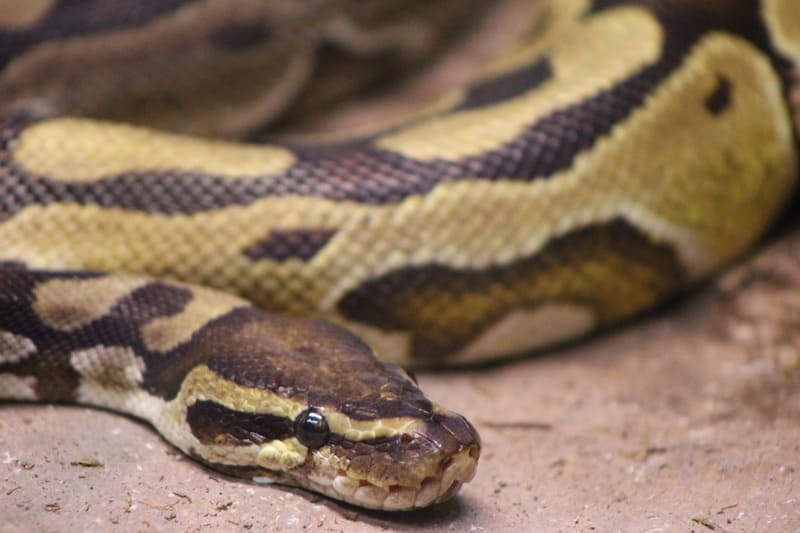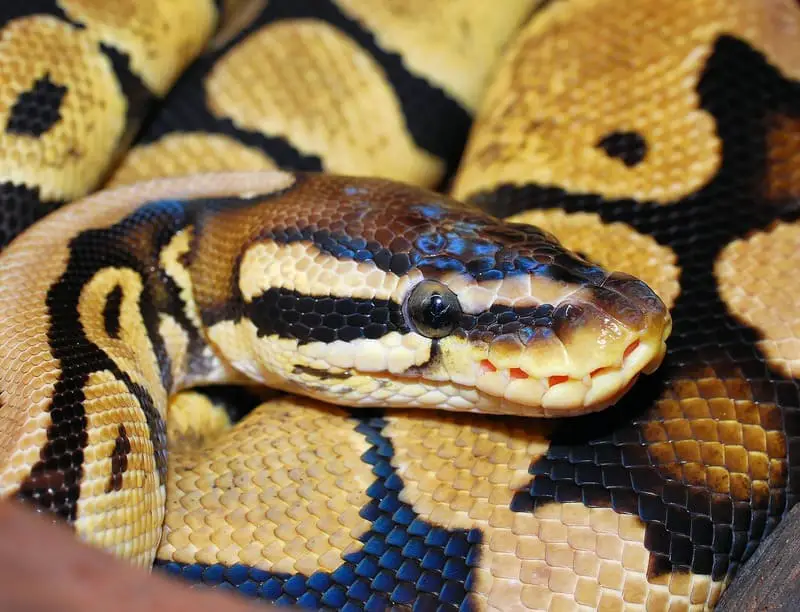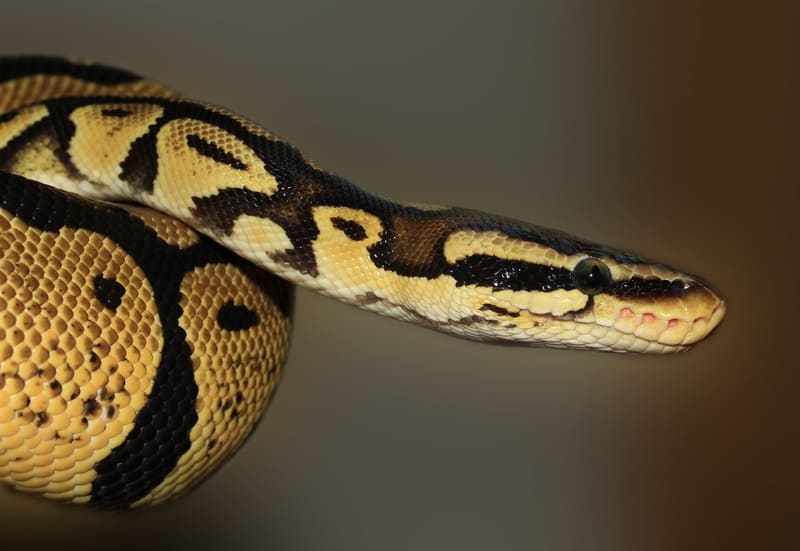Ball pythons are one of the most popular snake species kept as pets. They are admired for their docile nature, manageable size, and captivating appearance. However, for those considering or already caring for ball pythons, understanding their dietary needs is crucial. In this comprehensive guide, we will explore everything you need to know about what ball pythons eat, their feeding habits, dietary requirements, and the best practices for keeping these captivating snakes well-fed and healthy.

Natural History of Ball Pythons
Before delving into the dietary aspects of ball pythons, it’s essential to understand their natural history and behavior, as these factors play a significant role in determining their dietary preferences and feeding habits.
Origin and Habitat
Ball pythons are native to the forests and savannas of West and Central Africa. Their range spans countries such as Ghana, Togo, Benin, Nigeria, Cameroon, and Sudan. Within these regions, they are known for their terrestrial habits, where they primarily inhabit grasslands, shrublands, and the edges of forests.
Behavior
Ball pythons are known for their shy and secretive nature. They are often found hiding in burrows, termite mounds, or other concealed locations during the day. Their name “ball python” is derived from their defensive behavior of curling into a ball when they feel threatened. This protective posture covers their head and vital organs, making them challenging to harm.
Nocturnal Lifestyle
Being primarily nocturnal, ball pythons are most active during the nighttime. They have excellent heat-sensing pits on their upper lip, which helps them locate warm-blooded prey items, such as rodents and birds, in the dark. They are slow-moving and typically ambush their prey, relying on their constriction to subdue it.
What Do Ball Pythons Eat in the Wild?
In their natural habitat, ball pythons are carnivorous and primarily feed on small mammals, birds, and sometimes reptiles. Their diet typically consists of the following:
- Rodents: In the wild, ball pythons primarily target rodents such as rats and mice. These small mammals provide the necessary nutrients and energy for their survival and growth.
- Birds: On occasion, ball pythons will prey on birds, particularly those nesting in low-lying shrubs or trees. This dietary diversity helps them adapt to variations in their environment.
- Reptiles: While not their primary food source, ball pythons may also consume reptiles such as lizards and small snakes when other food options are scarce.
Their dietary choices are influenced by the availability of prey in their habitat. Ball pythons are opportunistic feeders, meaning they will eat what is available to them, and their diet can be quite variable as a result.
Ball Python Feeding Habits
Understanding the feeding habits of ball pythons is essential for keeping them healthy and ensuring they receive the proper nutrition in captivity. Here are some key aspects of their feeding habits:
1. Nocturnal Feeders
Ball pythons are most active and inclined to feed during the night. In their natural habitat, they use their heat-sensing pits to locate warm-blooded prey items in the dark. In captivity, it is recommended to feed them in the evening or at night when they are naturally more alert and responsive to food.
2. Ambush Predators
Ball pythons are ambush predators, meaning they do not actively hunt their prey. Instead, they lie in wait for an unsuspecting animal to come within striking distance. Once the snake detects a suitable target, it will strike and constrict the prey until it is subdued.
3. Reliance on Heat Sensors
These snakes rely heavily on their heat-sensing pits to detect prey. They can sense the heat radiating from warm-blooded animals, allowing them to strike with great accuracy in low-light conditions. This is why it’s essential to offer properly heated prey items in captivity.
4. Ingestion of Whole Prey
Ball pythons typically swallow their prey whole. They have a flexible lower jaw that allows them to consume prey items larger than their head. The process of swallowing can take several minutes, and it may appear slow and deliberate.
5. Post-Feeding Behavior
After consuming a meal, ball pythons exhibit a distinct behavior known as the “post-feeding shed.” During this period, they will remain relatively inactive, and their coloration may appear slightly dull or faded. This is a natural response to digestion, and it is crucial to avoid disturbing the snake during this time.

Feeding Ball Pythons in Captivity
Feeding ball pythons in captivity requires careful consideration of their dietary needs and the provision of appropriate prey items. Whether you are a new ball python owner or an experienced reptile enthusiast, here are the key factors to keep in mind:
1. Prey Items
In captivity, ball pythons should primarily be fed rodents. The most common prey items are mice and rats. The choice of prey item depends on the size and age of the snake.
- Hatchlings and juveniles: Hatchling ball pythons can be fed appropriately sized mouse pinkies. As they grow, you can gradually increase the size of the prey items, transitioning to mouse fuzzies and eventually small rats.
- Adults: Adult ball pythons should be fed adult-sized rats. The frequency of feeding depends on the individual snake’s age, size, and metabolism.
2. Prey Size and Frequency
The size of the prey item should be proportionate to the snake’s girth. A general guideline is to offer prey items that are about the same width as the snake’s widest part. Feeding prey items that are too large can lead to regurgitation or other digestive issues.
- Hatchlings: Young ball pythons can be fed once every 5-7 days.
- Juveniles: As they grow, the interval between feedings can be extended to every 7-10 days.
- Adults: Adult ball pythons can be fed every 10-14 days.
It’s crucial to monitor your snake’s body condition and adjust the feeding schedule accordingly. Overfeeding can lead to obesity, while underfeeding can result in malnutrition.
3. Prey Temperature
When offering prey items to ball pythons in captivity, it’s important to ensure that the prey is at an appropriate temperature. This helps replicate the natural hunting experience where the snake detects the heat signature of its prey.
To achieve this, you can warm the prey item by placing it in hot water for a few minutes or using heat lamps specifically designed for this purpose. Make sure the prey item is not too hot to avoid burning the snake.
4. Feeding Environment
Feeding your ball python in a separate enclosure is a common practice and is recommended. This helps reduce the risk of the snake ingesting substrate or other foreign objects during feeding. Using a dedicated feeding container or enclosure also helps condition the snake to associate that space with feeding time.
5. Handling Prey Items
When offering prey to your ball python, avoid using your bare hands. Instead, use feeding tongs or forceps to present the prey item. This minimizes the chance of the snake accidentally biting you instead of the prey. Gently wiggle the prey item to simulate movement and trigger the snake’s feeding response.
6. Monitoring and Observation
During the feeding process, it’s essential to observe your snake’s behavior. If the snake shows interest in the prey and strikes it, it’s a good sign that it’s hungry. However, if the snake ignores the prey or displays no interest, it’s best to remove the prey item to prevent it from getting injured or stressed.
7. Regurgitation
Regurgitation is the involuntary expulsion of a meal after it has been ingested. This can occur for various reasons, including handling the snake too soon after a meal, offering prey that is too large, or environmental stress. If your ball python regurgitates a meal, it’s crucial to wait at least a week before offering food again to allow the digestive system to recover.
Nutritional Considerations
Proper nutrition is critical to the health and well-being of your ball python. To ensure they receive a balanced diet, it’s important to consider the following factors:
1. Variety
While rodents are the primary prey for ball pythons, offering variety in their diet can help provide a broader range of nutrients. You can occasionally include other prey items such as chicks or quail to diversify their diet. However, these should not make up the majority of their meals.
2. Calcium and Supplements
Calcium is an essential nutrient for bone health in ball pythons. Dusting prey items with calcium powder before feeding can help ensure they receive adequate calcium. Some keepers also use reptile vitamin and mineral supplements sparingly, but it’s essential not to overuse them, as excess supplementation can lead to health issues.
3. Water
Hydration is a crucial aspect of a ball python’s overall health. Although they don’t drink water in the same way mammals do, they may soak in their water dish occasionally. Always provide fresh, clean water for your snake. Maintaining proper humidity in their enclosure can also help prevent dehydration.
4. Health and Body Condition
Regularly monitor your ball python’s health and body condition. A healthy snake will have a good body condition with a visible waistline. Overweight snakes are more prone to health issues, while underweight snakes may not be receiving enough nutrition.
If you have any concerns about your snake’s health or diet, consult with a veterinarian experienced in reptile care. Regular veterinary check-ups are also advisable to ensure your snake’s long-term well-being.

Common Feeding Issues
Feeding ball pythons in captivity can sometimes present challenges and common issues. It’s important to be aware of these potential problems and how to address them:
1. Refusal to Eat
Occasional refusal to eat is common among ball pythons and is not necessarily a cause for concern. It can be due to factors like stress, shedding, or changes in the environment. If your snake refuses a meal, remove the prey item and try again in a week or so. It’s essential not to force-feed your snake, as this can be harmful.
2. Regurgitation
As mentioned earlier, regurgitation can occur for various reasons. It’s essential to address the underlying cause and avoid feeding the snake for at least a week after regurgitation. If regurgitation becomes a recurring issue, consult with a veterinarian to rule out any health concerns.
3. Obesity
Overfeeding is a common issue in captive ball pythons and can lead to obesity. It’s crucial to monitor your snake’s body condition and adjust the feeding schedule accordingly. Reducing the size and frequency of meals can help overweight snakes shed excess weight.
4. Dietary Supplements
While calcium and vitamin supplements can be beneficial in moderation, overuse can lead to health problems. Follow the recommended guidelines for supplementing your snake’s diet and consult with a veterinarian if you have concerns.
Transitioning to Pre-Killed or Frozen-Thawed Prey
In some cases, ball pythons may have been raised on live prey before coming into your care. Feeding live prey presents certain risks, as the prey item can injure the snake during a live feeding event. To mitigate these risks, many keepers transition their snakes to pre-killed or frozen-thawed prey. Here’s how you can make the switch:
- Determine the snake’s preference: Some ball pythons readily accept pre-killed or frozen-thawed prey, while others may be more accustomed to live prey. Begin by offering pre-killed or frozen-thawed prey, and if the snake refuses, you can try live prey. Gradually reduce the frequency of live prey offerings to encourage acceptance of pre-killed or frozen-thawed prey.
- Scenting: If your ball python refuses to eat pre-killed or frozen-thawed prey, you can try “scenting” the prey item with a live animal’s scent. Rubbing a live rodent on the pre-killed or frozen-thawed prey can make it more enticing to the snake.
- Thawing and Warming: If you’re offering frozen-thawed prey, ensure that it is adequately thawed and warmed to mimic the temperature of a live animal. Use warm water to thaw and warm the prey item before presenting it to the snake.
- Be patient: Transitioning to pre-killed or frozen-thawed prey may take time and patience. Some ball pythons may resist the change initially, but with persistence, many can be successfully transitioned.
Conclusion
Understanding what ball pythons eat is fundamental to their care in captivity. These fascinating and docile snakes require a diet primarily composed of rodents, with the prey size and frequency adjusted based on their age and size. Maintaining proper prey temperature and using feeding tongs or forceps to handle the prey are essential practices.
In addition to their dietary needs, it’s vital to consider the nutritional aspects of their diet, including calcium supplementation and a fresh water source. Regular monitoring of their health, body condition, and addressing common feeding issues is crucial for the long-term well-being of ball pythons in captivity.
By providing a balanced and appropriate diet, you can ensure that your ball python remains healthy and thrives in your care. Remember that every snake is an individual, and their preferences and needs may vary, so it’s essential to be patient and adaptable in meeting their dietary requirements.
